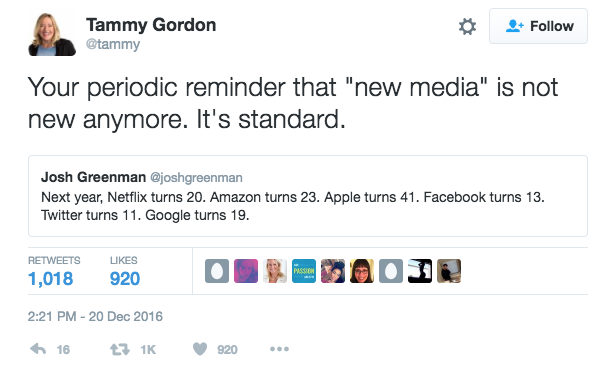10 Social Listening Tools and Who They’re Best for
By BrandwatchJul 14
Join us and boost your social media potential with our data-led event
Published May 4th 2017
As I referenced in my last article, here are the skills I believe a social analyst should be working on now, and in the future. Let’s get to it.
Remember big data? That is probably one of the few expressions that marketers hate more than “social media guru” and “viral”. The concept still stands today – that data is growing exponentially at an alarming rate.
What’s rarely discussed, however, is the analyst’s role in this – sure, so much data, marketers love data…but I think deep down what marketers really love is the knowledge that they have data available, more than the love for the data itself.
Now, while we’re used to referring to platform like Facebook, Twitter, Snapchat etc. as “social platform”, “social channels”, “social networks” – these same platforms are shedding the “social” title from their name, because they want to be more than just a social network.
Go to their sites, and you’ll find that they’re erasing traces of being a “social platform”, deleting or amending sentences that they used to call themselves that.
Ask the representatives from these companies if you know them, and it’s very likely that they won’t call their company a social platform anymore.
Useless trivia of the day: you can search for any question in the Facebook Help Centre, but “what is Facebook?” is the only question that I’ve found forces it to crash…some sort of existential crisis perhaps?
Anyway, I digress again.

These platforms want to break out from the box of “social networks”, along with all the preconceptions, expectations and connotations attached to what being a social network means.
They’re a network between people and people, and between people and bots, and between bots and bots.
This is more than we envisioned, but not more than what analysts can take. How do we handle this? Stop seeing the separation between social and non-social data – the lines are blurred now, so let’s just call it digital data and be comfortable with it.
Look at the various types of new data available, for example, data from virtual, augmented, and mixed reality.
Learn to get to grips with new digital tools and digital means of communications – how would you measure the success and performance of a Facebook chatbot, for instance? If your company were to start using machine learning today as part of your digital strategy, how would your approach its analytics?
That’s the sort of thing you should be asking yourself as you navigate 2017 – trust me, digital marketing will be less of the same, social media will do less of the same, your users will get used to doing less of the same – and so should you with your approach to digital data.

No rush, but you should totally learn Python and R.
I may write a separate piece on why this is important for analysts to future-proof their career, but these two languages will help you become an independent analyst, without having to rely so much on so many tools, while being able to look at data and manipulate it in more way than dear Excel can offer.
Aspire to be an independent analyst.
Knowledge of business intelligence tools like Power BI, Tablo and Watson will be essential, and while they won’t replace your job, they’ll be a toolset you need to be familiar with. If you rely on free tools for social analytics or social listening, your free ride will most likely end in 2017.
It’s useful for you to have a really intelligent tool like Brandwatch, and know how to get your own data. My idol James Whatley and Marshall Manson from Ogilvy break this down perfectly and beautifully in their Key Digital Trends for 2017 report.
Back to business intelligence tools – get chummy with them.

No worries if you don’t have the budget: for some reason, one of the smartest self-service business intelligence tools out there, Power BI, offers a free package, and if you’re an analyst who’s just getting started with BI or you’d like to dip your toes in it, it is more than enough. For seasoned analysts, you might want to tell your manager to invest in the paid plan if it fits your requirements.
Use tools like this and learn how to pull data from multiple sources within it. Use tools like this to look at the bigger picture – it is one thing to have the mentality that promotes that, it’s another to actually use the tool to go ahead and do it. Yes, big data is awesome, but don’t drown in it when there are tools like this around to make things so much easier.
Demographics, psychographics, user behavior – yes, we’ve had bits and pieces of that data for a lot of platforms for a few years now, some platforms offering more mature data than others.
Why is this going to be important? Because you can predict NPS. Because you can predict churn and acquisitions. Because automation will hit a new curve next year. Because being able to offer the best conversion aids for users based on their behavior is the smart way to do it.
And really, because the user expects you to, not in an intrusive way, not in a way that makes them feel like their data is vulnerable, but in a way that is ethical – yes, there is a sweet spot where you don’t have to compromise on data (quality and volume), and not compromise on trust.

Predictive analytics isn’t new, but we’ve not done enough with it. How do you start? You don’t have to start big: turn to social listening for intent analysis. Do you see people talking about an intent to convert or an intent to churn? What about your competitors, do you track that for their customers too?
If so, based on that analysis, how can you tailor your site’s behavior or your app behavior or the behavior or whatever digital asset you use based on their experience, and based on where they fit in your predictive models? Predicting user behavior drives better leads – fact.
The tools in the industry are getting better and better at automation and behavior analysis – another fact. The question is: how are you going to use the data you have available (social, digital, whatever you want to call it) to facilitate those better leads?
In a nutshell, the social analyst of 2016 will survive 2017 if they focus less on the social micro-picture and more on the digital macro-picture, being able to use data ethically for behavior prediction, while becoming more independent and (quasi) self-sufficient with a decent programming knowledge.
These three point to one thing that I see happening in 2017: the death of the social media analyst.
I’ll explain: the need of having a specialist looking into only social data is getting less and less important, while the request for a more holistic approach increases.
Now, is it a must for you to have all these skills? Well, let’s put it this way – you won’t be out of a job today if you don’t have those skills as a social media analyst. However, if you want to future-proof your career, you should totally have them under your belt.
I’ll put my hands up and say that yes, I have been learning how to program in Python and R to play around with social data, very quietly in my own time, and yes I have been trialling and failing and trialling and succeeding at manipulating data and extrapolating it and doing all sort of circus tricks with it. Sure, none of it is easy, but here’s for perspective:

In 2017, LinkedIn turns 14, Facebook turns 13, YouTube turns 12, Twitter turns 11, Tumblr turns 10, Sina Weibo and WhatsApp turn 8, Instagram turns 7, Snapchat turns 6… and I could go on with this “digital media birthday countdown” but the point is: new technology will arise in 2017 that will be a lot smarter than all of these platforms combined.
These older platforms will need to rise above it, and with all this technology evolving left and right – you don’t want to be the analyst left behind in this evolution process.
There was a lot to see at the last #NYKCONF, one of my main highlights being Dr Paul Siegel.
Remember the name.
I’ve met a lot of data-passionate people in my lifetime, but nothing prepared me for Dr Paul Siegel.
He reignited some fire in me, and it reminded me of why I became an analyst. He painted the most beautiful picture of a data-filled world I want to live in…and then he reminded me, that I live in it and that as an analyst I have the keys to it. It felt amazing. You can find his session recorded here.
Offering up analysis and data on everything from the events of the day to the latest consumer trends. Subscribe to keep your finger on the world’s pulse.
What skills will researchers need to sharpen to make 2023 a successful year? Learn how industry professionals are adapting..
Existing customer?Log in to access your existing Falcon products and data via the login menu on the top right of the page.New customer?You'll find the former Falcon products under 'Social Media Management' if you go to 'Our Suite' in the navigation.
Brandwatch acquired Paladin in March 2022. It's now called Influence, which is part of Brandwatch's Social Media Management solution.Want to access your Paladin account?Use the login menu at the top right corner.